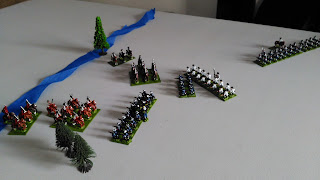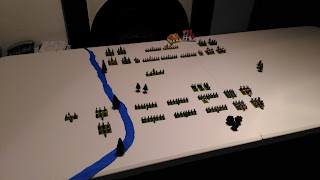THESE rules for refighting battles from the War of the Austrian Succession are adapted, heavily at times, from Neil Thomas's books, particularly Wargaming: An Introduction and Napoleonic Wargaming, with an assist to Keith Flint's Honours Of War.
 |
| You may need to read Neil Thomas's inspiring books to find the reasoning behind some of my rules |
ORGANISATION
An army is divided into battalions of foot, squadrons of horse and guns. All use bases 40mm x 20mm.
Most foot have 16 muskets in two ranks, and a separate officer figure. Light infantry have six muskets in loose formation, and a separate officer figure. The bases are in a line, giving a frontage of 80mm.
Horse have six troopers and a separate officer figure. Light cavalry are distinguished by having a more ragged formation. The bases are usually in two ranks, but light cavalry in a screening role may deploy in one rank.
A gun and its crew use the same size base but with one of the 20mm sides as the front. I originally added horses and a limber on a similar base, but have dispensed with them as they take up too much space.
The officer figures are used to help show casualties, or rather loss of effectiveness.
For example, a battalion of line infantry at full effectiveness consists of two bases in line with the 'officer' (it could be a drummer) placed centrally behind.
When a hit is suffered, move the officer to the right to show 25 percent effectiveness has been lost.
When a second hit is suffered, remove one base and centrally place the officer figure behind the remaining base, indicating 50 percent effectiveness remains.
When a third hit is suffered, remove the officer figure, showing just 25 percent effectiveness remains.
Each army also has a general, on a base 20mm by 20mm.
An army has lost when its number of units, including the general, has fallen below a third of its starting number.
TURN SEQUENCE
1. Dice for the right to move first. The winner moves a unit, then the opponent moves, and so on alternately until both players have moved as many units as desired.
2. Musketry and artillery fire. All firing is considered simultaneous.
3. Melee.
MOVEMENT Regular foot in firing order (ie in line in good order, able to fire volleys): 6cm
All other foot: 7.5cm
Artillery: 6cm
Heavy horse: 10cm
Light horse and generals: 12cm
It takes a complete turn for foot to change into firing order.
Light troops may make a half move and fire, or fire and make a half move. No other troops may move and fire in the same turn.
Guns take a turn to limber or unlimber. Pivoting counts as movement but can de done as part of unlimbering. If limbers are on the table, they are only there for aesthetic reasons - they cannot be fired at, do not count as cover and should be moved out of the way if another unit wants to use the space they are occupying.
Troops may wheel 45 degrees without penalty. Wheeling further costs half a turn. An about-turn is free, but a second in the same turn costs half the movement distance.
Charging, ie movement intended to result in a melee, must not involve a wheel of more than 45 degrees and any wheel must occur in the first half of the distance covered. Only one unit can contact each face of an enemy unit.
Light infantry can be interpenetrated by friendly troops provided the friendly unit's move distance will take it beyond the light infantry. Similarly, light infantry can interpenetrate friendly units.
The Variation Roll a die for a unit moving its full distance, or within 25 per cent of its full distance.
6...add 25% to the distance covered.
2-5...no change.
1...subtract 25% from the distance covered.
This simulates those ground fluctuations and other unexpected matters that affect movement but are out of control and consideration of an army's general. It should be ignored when the result would be ridiculous, eg a unit sent to defend a river bank being forced into the river.
MUSKETRY Foot and light horse, except for lancers, can fire.
Musket range: 8cm.
Carbine range: 4cm.
Roll one die for each 25 per cent of a unit's effectiveness remaining and in a single line of bases. The scores needed for a hit are:
Regular foot in firing order: 4-6.
Light foot: 5-6.
Light horse and regular foot not in firing order: 6.
ARTILLERY Canister: 0-12cm. Roll two dice (one if effectiveness 50 per cent or lower).
Roundshot: up to 24cm. Roll one die (halve if effectiveness 50 per cent or lower).
Halve the score to get the potential number of hits (rounding as normal, except that a half is diced for).
Each potential hit is diced for with a 4-6 scoring a hit on foot and horse, a 6 on guns.
Guns on a hill can fire roundshot over the heads of friendly troops who are at least two contours lower and are nearer the guns than the target. The initial die throw is reduced by 1 (before halving to get the number of potential hits).
SAVING THROWS Troops in cover cancel a hit from firing with a throw of 4-6.
Cuirassiers cancel a hit from firing with a throw of 6.
Each hit reduces a unit's effectiveness by 25 per cent.
MELEES There is no bonus for charging (the precise details of how two units come to clash is considered to be at a tactical level far below the control of a general) but there are restrictions on who can charge whom.
Foot may not charge horse.
Artillery and light infantry never charge and never inflict casualties in a melee. Exception: light infantry in a wood or built-up area melee as close-order foot.
A gun may only be charged if it has no close-order foot within 4cm. Artillery is automatically eliminated in a melee.
Roll the following number of dice per 25 per cent of effectiveness remaining:
Enemy unit Hvy Cav...Lance...Other Lt Cav...Cl Ord Inf*...Cl Ord Inf^...
Lt Inf
Own unitHeavy Cav 1 2 2 1 3 2
Lancers 1 1 1 1.5 4 4
Other Lt Cav 1 2 1 1 2 3
Close Order Inf 1 1 1 1 1 1
*in firing order and attacked frontally
^all other close-order infantry
Throw an extra die per 25 per cent effectiveness when attacking in flank or rear, on higher ground or defending a river bank or built-up area.
A half-die has a 50:50 chance of becoming a full die.
A hit is inflicted on throwing a 4-6.
Troops in cover have a saving throw of 4-6. Cuirassiers have a saving throw of 6.
Frontally-charged foot may always fire.
After a round of meleeing, the unit suffering the most hits, including any inflicted by firing, retreats a full move - with the usual possible distance-variation adjustment - and ends the move with its back to the enemy. A tie results in another round of meleeing on the following turn.
A retreating unit is eliminated if its retreat is obstructed by another unit that is not light infantry or artillery.
If the blocking unit is friendly, it must take a morale test, unless it is cavalry retreated into by infantry.
MORALE Test when a unit loses at least 25 per cent effectiveness from firing or loses a melee.
Roll a die. If the following score is not made, remove a further 25 per cent effectiveness.
Elite: 3-6.
Regular: 4-6.
Poor, militia: 5-6.
A general may be attached to any unit. Such a unit adds 1 to a morale throw. The general may switch units but is eliminated if the unit it is with is eliminated.
NATIONAL CHARACTERISTICS
These can be decided on a battle-by-battle basis.
Example: Mollwitz.
Prussian foot add 1 to musketry throws. They suffer no movement penalty for wheeling
Prussian horse in melees inflict a casualty on a throw of 5 or 6 instead of the usual 4-6. All wheeling costs half a move.










































